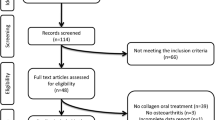Abstract
Purpose
Self-rated health is a commonly used patient-reported outcome, but its responsiveness to is not well documented. We examined the ability of self-rated health to capture health changes attributable to a highly effective surgical intervention.
Methods
Prospective study of patients with severe osteoarthritis of the hip (N = 990) or knee (N = 907) who underwent total hip replacement (THA) or total knee replacement (TKA). Self-rated health was assessed pre-operatively and 1 year after surgery on a scale between “excellent” and “poor,” along with other health items (other 11 items of the SF12 questionnaire) and multi-item Pain and Function scales.
Results
On average, self-rated health was unchanged by surgery. In both THA and TKA cohorts, of 10 patients, 6 rated their health the same after surgery as before, 2 gave a higher rating, and 2 gave a lower rating. In contrast, major improvements were observed for all other SF12 items, and for the Pain and Function scales, in both cohorts of patients. Nevertheless, both before and after surgery, self-rated health was associated with the other SF12 items and with Pain and Function scores. These associations were stronger after surgery than before.
Conclusions
Self-rated health was not responsive to major improvements in health, documented by other instruments, attributable to joint replacement surgery. However, self-rated health was even more strongly associated with concurrent assessments of more specific health problems after surgery than before. Caution is advised in interpreting changes in self-rated health following health-altering interventions.

Similar content being viewed by others
References
Jylhä, M. (2009). What is self-rated health and why does it predict mortality? Towards a unified conceptual model. Social Science & Medicine, 69, 307–316.
Fayers, P. M., & Sprangers, M. A. G. (2002). Understanding self-rated health. Lancet, 359, 187–188.
Garbarski, D. (2016). Research in and prospects for the measurement of health using self-rated health. Public Opinion Quarterly, 80, 977–997.
DeSalvo, K. B., Bloser, N., Reynolds, K., He, J., & Muntner, P. (2005). Mortality prediction with a single general sefl-rated health question: A meta-analysis. Journal of General Internal Medicine, 21, 267–275.
Lima-Costa, F. M., Cesar, C. C., Chor, D., & Proietti, F. A. (2012). Self-rated health compared with objectively measured health status as a tool for mortality risk screening in older adults: 10-year follow-up of the Bambui Cohort Study on Aging. American Journal of Epidemiology, 175, 228–235.
DeSalvo, K. B., Fan, V. S., McDonnell, M. B., et al. (2005). Predicting mortality and healthcare utilization with a single question. Health Services Research, 40, 1233–1246.
DeSalvo, K. B., Jones, T. M., Peabody, J., et al. (2009). Health care expenditure prediction with a single item, self-rated health measure. Medical Care, 47, 440–447.
Latham, K., & Peek, C. W. (2013). Self-rated health and morbidity onset among late midlife US adults. The Journals of Gerontology, 68, 107–116.
Perneger, T. V., Gayet-Ageron, A., Courvoisier, D. S., Agoritsas, T., & Cullati, S. (2013). Self-rated health: Analysis of distances and transitions between response options. Quality of Life Research, 22, 2761–2768.
Meng, X., & D’Arcy, C. (2016). Determinants of self-rated health among Canadian seniors over time: A longitudinal population-based study. Social Indicators Research, 126, 1343–1353.
Bailis, D. S., Segall, A., & Chipperfield, J. G. (2003). Two views of self-rated general health status. Social Science & Medicine, 56, 203–217.
Lübbeke, A., Garavaglia, G., Barea, C., & Hoffmeyer, P. Why do we need hospital-based registries? The Geneva Hip Arthroplasty Registry. EFORT publication 2010. Accessed February 26, 2018, from http://www.rpa.spot.pt/getdoc/0071e52c-7cdf-4d4e-86f7-5266c8b15bfb/The-Geneva-Hip-Arthroplasty-Registry_E-BOOK_Table-.aspx.
Gandek, B., Ware, J. E., Aaronson, N. K., et al. (1998). Cross-validation of item selection and scoring for the SF-12 Health Survey in nine countries: Results from the IQOLA Project. International quality of life assessment. Journal of Clinical Epidemiology, 51, 1171–1178.
Leplège, A., Ecosse, E., Verdier, A., & Perneger, T. V. (1998). The French SF-36 Health Survey: Translation, cultural adaptation, and preliminary psychometric evaluation. Journal of Clinical Epidemiology, 51, 1013–1023.
Whitehouse, S. L., Lingard, E. A., Katz, J. N., & Learmonth, I. D. (2003). Development and testing of a reduced WOMAC function scale. The Journal of Bone and Joint Surgery (British), 85, 706–711.
Zahiri, C. A., Schmalzried, T. P., Szuszczewicz, E. S., & Amstutz, H. C. (1998). Assessing activity in joint replacement patients. The Journal of Arthroplasty, 13, 890–895.
Perruccio, A. V., Davis, A. M., Hogg-Johnson, S., & Badley, E. M. (2011). Importance of self-rated health and mental well-being in predicting health outcomes following total joingt replacement surgery for osteoarthritis. Arthritis Care & Research, 63:973–981.
Sprangers, M. A., & Schwartz, C. E. (1999). Integrating response shift into health-related quality of life research: A theoretical model. Social Science & Medicine, 48, 1507–1515.
Barclay-Goddard, R., Epstein, J. D., & Mayo, N. E. (2009). Response shift: A brief overview and proposed research priorities. Quality of Life Research, 18, 335–348.
Ubel, P. A., Peeters, Y., & Smith, D. (2010). Abandoning the language of “response shift”: A plea for conceptual clarity in distinguishing scale recalibration from true changes in quality of life. Quality of Life Research, 19, 465–471.
Razmjou, H., Yee, A., Ford, M., & Finkelstein, J. A. (2006). Response shift in outcome assessment in patients undergoing total knee arthroplasty. JBJS, 88, 2590–2595.
Zajacova, A., & Dowd, J. B. (2011). Reliability of self-rated health in US adults. American Journal of Epidemiology, 174, 977–983.
Garbarski, D., Dykema, J., Croes, K. D., & Edwards, D. F. (2017). How participants report their health status: cognitive interviews of self-rated health across race/ethnicity, gender, age, and educational attainment. BMC Public Health, 17, 771.
Funding
The Geneva Arthroplasty Registry is supported in part by the Fondation pour la Recherche Ostéo-Articulaire.
Author information
Authors and Affiliations
Corresponding author
Ethics declarations
Conflict of interest
The authors declare that they have no conflicts of interest.
Rights and permissions
About this article
Cite this article
Perneger, T., Lübbeke, A. The paradox of self-rated health following joint replacement surgery. Qual Life Res 28, 503–508 (2019). https://doi.org/10.1007/s11136-018-2018-x
Accepted:
Published:
Issue Date:
DOI: https://doi.org/10.1007/s11136-018-2018-x




